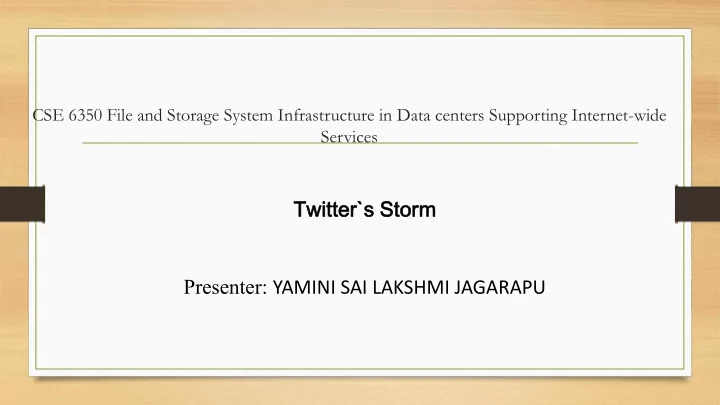

CSE 6350 File and Storage System Infrastructure in Data centers Supporting Internet-wide Services Tw Twitter ter`s `s St Storm Presenter: YAMINI SAI LAKSHMI JAGARAPU
CONTENTS • INTRODUCTION TO STORM • STORM FEATURES • STORM DATA MODEL • STORM ARCHITECTURE • MAP REDUCE VS STORM
INTRO TO STORM • Storm is real-time fault tolerant distributed stream processing system . • Storm is a real-time distributed stream data processing engine at twitter that powers the real-time stream data management tasks that are crucial to provide twitter services.
Question 1 : “ STORM IS A REAL-TIME DISTRIBUTED STREAM DATA PROCESSING ENGINE AT TWITTER THAT POWERS THE REAL-TIME STREAM DATA MANAGEMENT TASKS..” WHAT ARE THE FIVE FEATURES OF STORM? • Scalability: Add or remove nodes from Storm cluster without disrupting existing data flows through topology. • Resilient: Fault-tolerance is crucial to Storm as it is often deployed on large clusters, and hardware components can fail. • Extensibility: Storm topologies may call arbitrary external functions, and thus needs fa framework which allows extensibility
Cont ….. • Efficient: Since Storm is used in real-time applications; it must have good performance characteristics. • Easy to Administer: Since Storm is at that heart of user interactions on Twitter, end-users immediately notice if there are (failure or performance) issues associated with Storm.
STORM DATA MODEL • The basic Storm data processing architecture consists of streams of tuples flowing through topologies . A topology is a directed graph where the vertices represent computation and the edges represent the data flow between the computation components. Vertices are further divided into two disjoint sets – spouts and bolts.
Question 2: WHAT ARE TOPOLOGY, SPOUT, AND BOLT IN THE STORM DATA PROCESSING ARCHITECTURE? USE WORD COUNT APPLICATION AS AN EXAMPLE TO EXPLAIN THE CONCEPTS (FIGURE 1) AND ITS EXECUTION IN STORM (FIGURE 3). • Topology: Topology is a directed graph where the vertices represent computation and the edges represent the data flow between the computation components. • Spout: Spouts are tuple sources for the topology. Typical spouts pull data from queues. • Bolt: Process the incoming tuples and pass them to the next set of bolts downstream.
Q2 Cont.….. • TweetSpout may pull tuples from Twitter’s Firehose API. • The ParseTweetBolt breaks the Tweets into words and emits 2-ary tuples (word, count), one for each word. • The WordCountBolt receives these 2-ary tuples and aggregates the counts for each word, and outputs the counts ever 5 minutes.
Q2 Cont … Associated with each spout or bolt is a set of tasks running in a set of executors across machines in a cluster. Data is shuffled from a producer spout/bolt to a consumer bolt. Storm supports 5 types of partitioning strategies. As a part of the topology, the programmer specifies how many instances of each spout and bolt must be spawned.
STORM ARCHITECTURE Each worker node runs a Supervisor that communicates with Nimbus. The cluster state is maintained in Zookeeper, and Nimbus is responsible for scheduling the topologies on the worker nodes and monitoring the progress of the tuples flowing through the topology.
Question 3 : WHAT’S NIMBUS? USE FIGURE 2 TO EXPLAIN STORM’S HIGH LEVEL ARCHITECTURE. • Nimbus: Nimbus plays a similar role as the “ JobTracker ” in Hadoop, and is the touchpoint between the user and the Storm system. Nimbus is an Apache Thrift service and Storm topology definitions are Thrift objects. To submit a job to the Storm cluster (i.e. to Nimbus), the user describes the topology as a Thrift object and sends that object to Nimbus.
SUPERVISOR ARCHITECTURE • The heartbeat event, reports to Nimbus that the supervisor is alive. • Event manager thread . This thread is responsible for managing the changes in the existing assignments. • Process event manager thread . This thread is responsible for managing worker processes that run a fragment of the topology on the same node as the supervisor.
WORKER ARCHITECTURE • To route incoming and outgoing tuples, each worker process has two dedicated threads – a worker receive thread and a worker send thread. • Each executor consists of two threads namely the user logic thread and the executor send thread. • The global transfer queue contains all the outgoing tuples from several executors.
Question 4: COMPARE MAPREDUCE (OR HADOOP) WITH STORM Map reduce Storm • Hadoop MapReduce is best suited for • Storm can do real-time processing of batch processing. streams of Tuples. • Data is mostly static and stored in • It works on the continuous stream of data persistent storage. instead of stored data. • Latency is few minutes. • Latency is sub-second.
THANK YOU
Recommend
More recommend